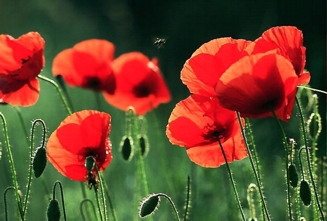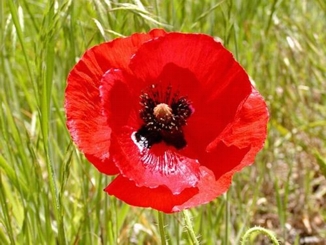|
|
| |
|
Plant name - Papaver rhoeas
|

|
|
 |
|
 |
| Common name - Papaver
|
| Plant type - Flowers - herb |
| Vegetation type -
Annual |
| Growth rate - fast |
| Leaf / Flower color
- Green / Red |
| Other names - Papaver rhoeas / Poppy |
| |
| Description : |
The flowers have two sepals that fall off as the bud opens, and four (or up to six) petals in red, pink, orange, yellow, or lilac. There are many stamens in several whorls around a compound pistil, which results from the fusion of carpels. The stigmas are visible on top of the capsule, and the number of stigmas corresponds to the number of fused carpels.
The ovary later develops into a dehiscing capsule, capped by the dried stigmas. The numerous, tiny seeds escape with the slightest breeze through the pores of the capsule.
The typical Papaver gynoecium is hypogenous with a globular ovary. The style is characteristically absent for the type species Opium Poppy, and several others, although those with a style do exist. The sessile plate-like stigmata lies on top of the ovary. Pollen-receptive surfaces.
The characteristic fruit type of Papaver is the unilocular capsule. The stigmatic disc rests on top of the capsule, and beneath it are dehiscent pores or valves.
|
| |
| Growing Instructions : |
*Fill a large pot with potting soil. The ideal pot is 10 inches or larger and the soil needs a pH level of about 7.0. Poppies prefer a soil that is light, sandy or gritty. Since poppies do not transplant very well, it is important to plant them in the right size container the first time.
* Pour the seeds into the palm of your hand. With thumb and forefinger, sprinkle the seeds on top of the soil. Don’t puddle the seeds in any one spot. Scatter them sparingly over the top.
* Cover the seeds with a fine layer of soil mixture. Do not cover them deeply, or they will not germinate.
* Water thoroughly. Place the pot in a container of water and allow the soil to drink up water. When the soil is wet, place under grow lights. Leave the grow lights on for 12 hours per day. Poppies germinate better if the temperature is around 60 degrees F.
* Use a spray bottle and mist the soil every day to keep the soil moist. Continue to keep the soil moist but not soggy.
* Stop misting when the flower buds form and reduce the amount of water that you are giving your poppies.
* Increase the light time to 16 hours per day when buds form. Keep the temperature between 68 and 75 degrees during the day. Nighttime temperatures should remain around 35 to 55 degrees Fahrenheit.
Also, the Poppy seeds is an excellent spice used in many recipes
|
| |
|
|
|
|
|
